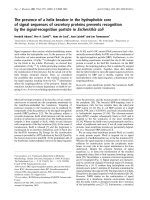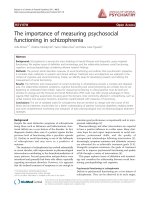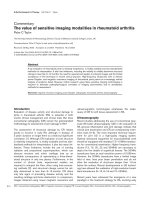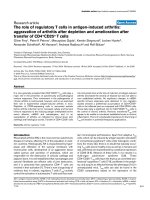Báo cáo y học: "The value of sensitive imaging modalities in rheumatoid arthritis pdf
Bạn đang xem bản rút gọn của tài liệu. Xem và tải ngay bản đầy đủ của tài liệu tại đây (44.07 KB, 4 trang )
210
CR = conventional radiography; MRI = magnetic resonance imaging; PD = power Doppler; RA = rheumatoid arthritis; US = ultrasonography.
Arthritis Research & Therapy Vol 5 No 5 Taylor
Introduction
Evaluation of disease activity and structural damage to
joints in rheumatoid arthritis (RA) is essential in both
routine clinical management and clinical trials. But does
conventional radiography (CR) remain the gold-standard
methodology for assessment of joint damage in RA?
The assessment of structural damage by CR relates
poorly to function in early RA, although in disease of
5 years’ duration or longer there is a weak but significant
correlation [1]. Although CR evaluation of joint structure
is relatively inexpensive, is widely available and has stan-
dardised methods for interpretation, it also has many lim-
itations. These limitations include the use of ionising
radiation and projectional superimposition, which can
obscure erosions and mimic cartilage loss as an
inevitable consequence of representing a three-dimen-
sional structure in only two planes. Furthermore, in the
context of clinical trials, experienced readers are
required to interpret the films, often using time-consum-
ing methods [2], and structural change cannot be reli-
ably determined in less than 6–12 months. CR offers
only late signs of preceding disease activity and the
resulting cartilage and bone destruction. In comparison,
images obtained using newer magnetic resonance and
ultrasonographic technologies emphasise the inade-
quacy of CR for soft tissue assessment in RA.
Ultrasonography
Recent studies addressing the use of conventional grey-
scale (B-mode) ultrasonography (US) in the evaluation of
RA synovial inflammation and joint damage indicate that
clinical joint examination and CR are comparatively insen-
sitive tools [3–5]. The most important technical require-
ment for joint US is a high-quality imaging system.
Optimal ultrasound equipment for musculoskeletal work
should be equipped with standard 7.5–10 MHz transduc-
ers for conventional examination. Higher frequency trans-
ducers (13, 15, 20, 22 and 30 MHz) are necessary to
depict the fine details of superficial tissues. The 20 MHz
transducers have an axial resolution power of 0.038 mm.
However, the 20 MHz transducers have a limited image
field of view, have poor beam penetration and do not
allow the evaluation of structures deeper than 1.5 cm
below the surface. Recent developments in US technol-
ogy have allowed the realisation of high-resolution broad-
band transducers (5–10, 8–16 and 10–22 MHz).
Recent years have witnessed the emergence of a new
paradigm in the treatment strategy for RA, involving early
Commentary
The value of sensitive imaging modalities in rheumatoid arthritis
Peter C Taylor
The Kennedy Institute of Rheumatology Division, Faculty of Medicine, Imperial College London, UK
Correspondence: Peter C Taylor (e-mail: ))
Received: 22 May 2003 Accepted: 2 Jul 2003 Published: 16 Jul 2003
Arthritis Res Ther 2003, 5:210-213 (DOI 10.1186/ar794)
© 2003 BioMed Central Ltd (Print ISSN 1478-6354; Online ISSN 1478-6362)
Abstract
X-ray evaluation of rheumatoid joints is relatively inexpensive, is widely available and has standardised
methods for interpretation. It also has limitations, including the inability to reliably determine structural
change in less than 6–12 months, the need for experienced readers to interpret images and the limited
acceptance of this technique in routine clinical practice. High-frequency ultrasound, with or without
power Doppler, and magnetic resonance imaging of rheumatoid joints permit an increasingly refined
analysis of anatomic detail. However, further research using these sensitive imaging technologies is
required to delineate pathophysiological correlates of imaging abnormalities and to standardise
methods for assessment.
Keywords: magnetic resonance imaging, power Doppler, radiography, rheumatoid arthritis, ultrasonography
211
Available online />and aggressive suppression of synovitis by means of phar-
macological intervention with drugs proven to modify the
rate of progression of structural damage to joints. Preser-
vation of joint integrity is closely associated with mainte-
nance of functional capability. However, many patients
with early RA are excluded from clinical studies because
radiology does not detect erosions. Furthermore, the intro-
duction of disease-modifying antirheumatic drugs may be
delayed because of the absence of radiological erosions.
In this circumstance, when the diagnosis of early RA is
suspected but the patient has yet to fulfil the necessary
number of classification criteria, imaging technologies
such as high-frequency US, particularly of the second and
third metacarpophalangeal joints and the fifth meta-
tarsophalangeal joint, may be very valuable to confirm the
presence of erosive disease.
While high-frequency (grey-scale) US measurements of
joint space are robust, showing reproducible delineation
of synovial thickening in small joints of the hands in
patients with active RA, the analysis of such images does
not necessarily demonstrate a clear relationship with clini-
cal assessments of disease activity [6]. This observation
probably reflects the fact that high-frequency US identifies
synovial thickening without differentiating actively inflamed
or fibrous tissue.
The additional use of Doppler techniques, in which a
signal generated by moving blood cells permits assess-
ment of vascularised synovium [3,7,8], might be predicted
to better reflect the presence of active synovitis. Large-
vessel blood flow is at high velocity and is readily detected
by conventional colour Doppler sonography that encodes
the mean Doppler frequency shift. However, blood flow at
the microvascular level, which is of interest with respect to
rheumatoid synovitis, is at a lower velocity and is less
readily detectable by this means.
In contrast, power Doppler (PD) sonography encodes the
amplitude of the power spectral density of the Doppler
signal and is a sensitive method for demonstrating the
presence of blood flow in small vessels. The PD signal is
actually a measure of the density of moving reflectors at a
particular level, and thus of the fractional vascular volume
[9,10]. PD is insensitive to flow in submillimetre vessels, in
common with most other ultrasound methods, and is thus
only an indirect surrogate for measurement of capillary
flow. Several recent studies have, however, demonstrated
that PD ultrasound is capable of detecting synovial hyper-
aemia in the inflamed RA joint [3,7,11,12] and that signal
intensity correlates well with histological assessment of
synovial membrane microvascular density [11]. Quantita-
tive PD assessment of vascularised synovium in the
metacarpophalangeal joints of patients with RA has been
reported to correlate with erythrocyte sedimentation rate
[6].
The close relationship between findings on PD and those
on gadolinium-enhanced magnetic resonance imaging
(MRI) are an encouraging indication that a synovial vascu-
lar signal on PD is associated with inflammatory
processes [8]. Three small, uncontrolled studies have
reported a reduction in the PD signal following therapeutic
intervention in RA [7,13,14]. The use of intravenous
microbubble echo-contrast agents may enhance the sen-
sitivity of a PD signal in RA joints [15], but with the dis-
advantages of cost, time and invasiveness.
The main advantages of US as compared with other
imaging techniques include the absence of radiation,
good visualisation of tendons and joint space, low running
costs, multiplanar imaging capability, and easy compari-
son with the contralateral side. US can be performed at
the bedside and is readily acceptable to patients.
However, the image acquisition procedure for high-
frequency US and PD has yet to be standardised, and the
quality of the examination is highly dependent upon the
skill of the operator and the use of optimal equipment. Fur-
thermore, there are potential problems with reproducibility
based on intra-observer and inter-observer variability and
the use of different machines.
Computed tomography
The tomographic perspective permitted by computed
tomography overcomes some of the limitations of CR and
permits particularly good definition of bony change.
However, it entails greater exposure to ionising radiation
and has an inferior sensitivity to changes in RA soft
tissues in comparison with US and MRI [16].
Magnetic resonance imaging
MRI has the capability to image all components of the joint
simultaneously and is more sensitive than clinical assess-
ment and CR for the detection of joint inflammation and
destruction [17,18]. The ability to distinguish between RA
joint effusion and synovial proliferation by MRI has been
greatly improved by the introduction of paramagnetic con-
trast agents. The early post-gadolinium synovial membrane
enhancement in RA joints, determined by dynamic MRI, is
considered to reflect synovial perfusion and permeability.
However, the image quality, and therefore interpretation,
will depend on a number of technical factors including the
magnet strength, the use of dedicated coils and the
choice of MRI sequences.
Attempts to standardise image acquisition, terminology and
quantification have been made by an international panel of
experts at Outcome Measures in Rheumatoid Arthritis con-
sensus conferences [19]. However, further clarification of
nomenclature for image abnormalities is required where
pathophysiological correlates are uncertain. For example,
MRI signs of increased water content in the bone marrow
compartment, generally termed ‘bone oedema’, are
212
Arthritis Research & Therapy Vol 5 No 5 Taylor
reversible but often associated with subsequent erosive
damage [18,20]. Difficulties may arise when it is assumed
that there is identity in the pathological basis of lesions
labelled as ‘erosions’ by different imaging modalities. For
example, only one in four lesions identified as ‘erosions’ on
MRI progress to CR erosions at the same site [21], and pro-
gression of CR hand scores may not be associated with
change in ‘erosions’ as determined by MRI at the meta-
carpophalangeal joints [22]. Mineralised bone does not
generate a signal on MRI, but is detected as the gap
between adjacent tissues containing mobile protons. Most
MRI ‘erosions’ appearing to be larger in volume than corre-
sponding lesions detected by CT may occur because MRI
depicts abnormalities in bone marrow around, as well as
filling, bone defects [23].
Much work yet remains to reduce the high inter-rater vari-
ability reported when various scoring methods are used in
the assessment of magnetic resonance images obtained
at different centres using slightly different means of image
acquisition [24]. One potential approach to this difficulty is
to develop quantitative techniques for measuring MRI syn-
ovial volumes and erosion volumes using image analysis
software [25]. Very low intra-observer variability is
reported for this methodology, but inter-rater variation, a
crucial issue if wider, reliable application in the context of
clinical trials is to be useful, remains to be tested.
Conclusions
It is evident that technological advances in imaging permit
an increasingly refined analysis of fine anatomic detail.
However, there is much work to be carried out in standar-
dising new imaging technologies in the assessment of RA
and in determining the pathophysiological correlates of
certain image abnormalities. It would therefore be prema-
ture to regard MRI or US as usurping the status of CR as
the recommended ‘gold standard’ for assessment of
structural damage to joints in the context of clinical trials.
Even so, we can conclude that these rapidly advancing
imaging technologies hold much promise as sensitive clin-
ical tools, with the potential to detect early changes in
inflammatory processes and joint destruction that may ulti-
mately permit reduced clinical trial size and duration, and
may permit better informed management decisions in a
bid to optimally suppress synovitis and improve treatment
outcomes.
Competing interests
None declared.
References
1. Scott DL, Pugner K, Kaarela K, Doyle DV, Woolf A, Holmes J,
Hieke K: The links between joint damage and disability in
rheumatoid arthritis. Rheumatology (Oxford) 2000, 39:122-132.
2. van der Heijde DM: Plain X-rays in rheumatoid arthritis:
overview of scoring methods, their reliability and applicability.
Baillieres Clin Rheumatol 1996, 10:435-453.
3. Hau M, Schultz H, Tony HP, Keberle M, Jahns R, Haerten R,
Jenett M: Evaluation of pannus and vascularization of the
metacarpophalangeal and proximal interphalangeal joints in
rheumatoid arthritis by high-resolution ultrasound (multi-
dimensional linear array). Arthritis Rheum 1999, 42:2303-2308.
4. Wakefield RJ, Gibbon WW, Conaghan PG, O’Connor P,
McGonagle D, Pease C, Green MJ, Veale DJ, Isaacs JD, Emery P:
The value of sonography in the detection of bone erosions in
patients with rheumatoid arthritis. Arthritis Rheum 2000, 43:
2762-2770.
5. Grassi W, Filippucci E, Farina A, Salaffi F, Cervini C: Ultrasonog-
raphy in the evaluation of bone erosions. Ann Rheum Dis
2001, 60:98-103.
6. Qvistgaard E, Rogind H, Torp-Pedersen S, Terslev L, Danneski-
old-Samsoe B, Bliddal H: Quantitative ultrasonography in
rheumatoid arthritis: evaluation of inflammation by Doppler
technique. Ann Rheum Dis 2001, 60:690-693.
7. Newman JS, Laing TJ, McCarthy CJ, Adler RS: Power Doppler
sonography of synovitis: assessment of therapeutic
response — preliminary observations. Radiology 1996, 198:
582-584.
8. Szkudlarek M, Court-Payen M, Strandberg C, Klarlund M, Klausen
T, Ostergaard M: Power Doppler ultrasonography for assess-
ment of synovitis in the metacarpophalangeal joints of
patients with rheumatoid arthritis: a comparison with dynamic
magnetic resonance imaging. Arthritis Rheum 2001, 44:2018-
2023.
9. Rubin JM, Adler RS, Fowlkes JB, Spratt S, Pallister JE, Chen JF,
Carson PL: Fractional moving blood volume: estimation with
power Doppler US. Radiology 1995, 197:183-190.
10. Bude RO, Rubin JM: Power Doppler sonography. Radiology
1996, 200:21-23.
11. Walther M, Harms H, Krenn V, Radke S, Faehndrich TP, Gohlke F:
Correlation of power Doppler sonography with vascularity of
the synovial tissue of the knee joint in patients with
osteoarthritis and rheumatoid arthritis. Arthritis Rheum 2001,
44:331-338.
12. Carotti M, Salaffi F, Manganelli P, Salera D, Simonetti B, Grassi
W: Power Doppler sonography in the assessmentof synovial
tissue of the knee joint in rheumatoid arthritis: a preliminary
experience. Ann Rheum Dis 2002, 61:877-882.
13. Hau M, Kneitz C, Tony H-P, Keberle M, Jahns R, Jenett M: High
resolution ultrasound detects a decrease in pannus vasculari-
sation of small finger joints in patients with rheumatoid arthri-
tis receiving treatment with soluble tumour necrosis factor
αα
receptor (etanercept). Ann Rheum Dis 2002, 61:55-58.
14. Terslev L, Torp-Pedersen S, Qvisgaard E, Kristoffersen H, Rogind
H, Danneskiold-Samsoe B, Bliddal H: Effects of treatment with
etanercept (Enbrel, TNFR:Fc) on rheumatoid arthritis evalu-
ated by Doppler ultrasonography. Ann Rheum Dis 2003; 62:
178-181.
15. Klauser A, Frauscher F, Schirmer M, Halpern E, Pallwein L, Herold
M, Helweg G, ZurNedden D: The value of contrast-enhanced
color Doppler ultrasound in the detection of vascularisation of
finger joints in patients with rheumatoid arthritis. Arthritis
Rheum 2002, 46:647-653.
16. Alasaarela E, Suramo I, Tervonen O, Lahde S, Takalo R, Hakala M:
Evaluation of humeral head erosions in rheumatoid arthritis: a
comparison of ultrasonography, magnetic resonance imaging,
computed tomography and plain radiography. Br J Rheumatol
1998, 37:1152-1156.
17. McQueen FM, Stewart N, Crabbe J, Robinson E, Yeoman S, Tan
PLJ, McClean L: Magnetic resonance imaging of the wrist in
early rheumatoid arthritis reveals a high prevalence of
erosion at four months after symptom onset. Ann Rheum Dis
1998, 57:350-356.
18. McGonagle D, Conaghan P, O’Connor, Gibbon W, Green M,
Wakefield RJ, Ridgway J, Emery P: The relationship between
synovitis and bone changes in early untreated rheumatoid
arthritis. A controlled magnetic resonance imaging study.
Arthritis Rheum 1999, 42:1706-1711.
19. Conaghan P, Edmonds J, Emery P, Genant H, Gibbon W,
Klarlund M, Lassere M, McGonagle D, McQueen F, O’Connor P,
Peterfy C, Shnier R, Stewart N, Ostergaard M: Magnetic reso-
nance in rheumatoid arthritis: summary of OMERACT activi-
ties, current status, and plans. J Rheumatol 2001, 28:
1158-1162.
213
20. McQueen FM, Stewart N, Crabbe J, Robinson E, Yeoman S, Tan
PJL, McLean L: Magnetic resonance imaging of the wrist in
early rheumatoid arthritis reveals progression of erosions
despite clinical improvement. Ann Rheum Dis 1999, 58:156-
163.
21. McQueen FM, Benton N, Crabbe J, Robinson E, Yeoman S,
McLean L, Stewart N: What is the fate of erosions in early
rheumatoid arthritis? Tracking individual lesions using X rays
and magnetic resonance imaging over the first two years of
disease. Ann Rheum Dis 2001, 60:859-868.
22. Klarlund M, Ostergaard M, Jensen KE, Madsen JL, Skjodt H,
Lorenzen I, the TIRA Group: Magnetic resonance imaging, radi-
ography and scintigraphy of the finger joints: one year follow-
up of patients with early arthritis. Ann Rheum Dis 2000, 59:
521-528.
23. Goldbach-Mansky R, Woodburn J, Yao L, Lipsky P: Magnetic
resonance imaging in the evaluation of bone damage in
rheumatoid arthritis: a more precise image or just a more
expensive one? Arthritis Rheum 2003, 48:585-589.
24. Ostergaard M, Klarlund M, Lassere M, Conaghan P, Peterfy C,
McQueen F, O’Connor P, Shnier R, Stewart N, McGonagle D,
Emery P, Genant H, Edmonds J: Interreader agreement in the
assessment of magnetic resonance images of rheumatoid
arthritis wrist and finger joints — an international multicenter
study. J Rheumatol 2001, 28:1143-1150.
25. Bird P, Lassere M, Shnier R, Edmonds J: Computerized mea-
surement of magnetic resonance imaging erosion volumes in
patients with rheumatoid arthritis: a comparison with existing
magnetic imaging scoring systems and standard clinical
outcome measures. Arthritis Rheum 2003, 48:614-624.
Correspondence
Peter C Taylor, Senior Lecturer and Honorary Consultant Rheumatolo-
gist, The Kennedy Institute of Rheumatology Division, Faculty of Medi-
cine, Imperial College London, 1 Aspenlea Road, London W6 8LH, UK.
Tel: +44 20 8383 4494; fax: +44 20 8748 3293; e-mail:
Available online />









